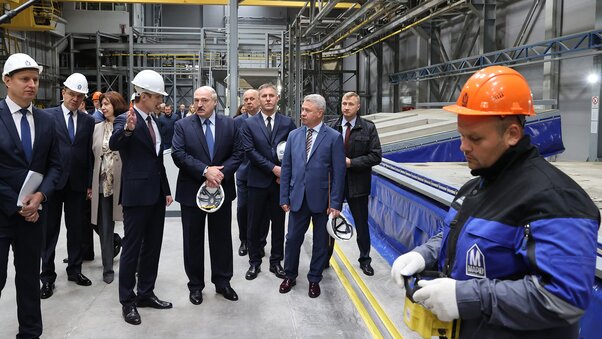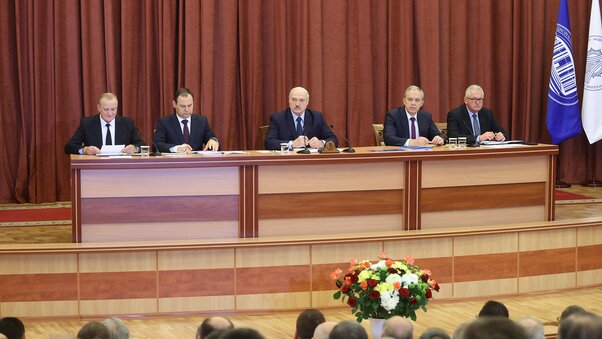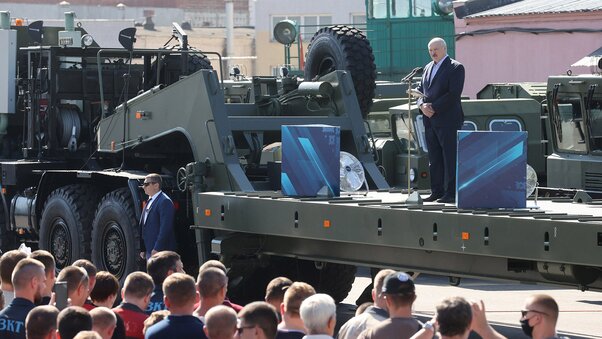Ceremony to inaugurate the Minsk metro third line
- 33
- 16:50
Belarus President Aleksandr Lukashenko took part in a solemn ceremony to inaugurate the Minsk metro third line that will span from the Kovalskaya Sloboda station to the Yubileinaya Ploshchad station on 6 November.
The head of state arrived at the Kovalskaya Sloboda station where he was welcomed by Minsk Metro Director Vladimir Sotnikov, Minskmetrostroy Director General Leonid Stukhalsky and other executives, as well as workers from the above-mentioned organizations.
After arriving at the Kovalskaya Sloboda station, Aleksandr Lukashenko inquired about the construction of the new line and the performance of the new equipment, in particular, the Alesya tunnel boring machine. The president also asked the Minsk metro top managers about how things are in the company’s labor collective. “If you are eager to work and do it effectively – thank you, we welcome this,” he noted.
So far, the third line includes four stations: Kovalskaya Sloboda, Vokzalnaya, Ploshchad Frantishka Bogushevicha, and Yubileinaya Ploshchad.
Minsk Mayor Vladimir Kukharev briefed the president on the work on the next stage which provides for building new stations in the southern direction. Plans are in place to build a line towards the Zeleny Lug neighborhood in 2023-2024.
Taking into account the development plans of the north of Minsk, where a smart city will be built in the future, Aleksandr Lukashenko also proposed to build a short metro line serving that part of the city.
According to Aleksandr Lukashenko, the Minsk metro development plan should also provide for the extension of the first line in the northwestern direction. It is time to start developing above-ground segments of the metro system, the head of state believes.
In order to take part in the ceremony, Aleksandr Lukashenko reached the station via the fare gate using an electronic card given to him by the staff of the Minsk metro.
“Today is an ordinary weekday in our country, but thanks to you we have a festive mood. We are putting into operation the first stage of the third metro line, which will dramatically change the life of the city - it will make it more dynamic and comfortable,” the president said addressing the attendees.
We were looking forward to the opening of the third line, Aleksandr Lukashenko said. “The Minsk metro has gone a long way since it opened 37 years ago. Thanks to being cheap, fast, and, most importantly, environmentally friendly, metro has become the busiest and most popular means of transport, we can say, a people’s means of transport,” the head of state said.
The Minsk metro handles more than 700,000 passengers a day, which is a third of the overall public transport ridership of Minsk. “The new line will help increase the passenger traffic of the metro as it will connect the southern and northern neighborhoods with the center of the capital,” Aleksandr Lukashenko pointed out.
He stressed that the construction of the four stations of the new line was finished despite this year’s challenges. “Nothing has stopped us in the course of this difficult year: neither the pandemic, nor the calls for strikes. You were busy working, just like the majority of Belarusians, thanks to whom the country lives and continues developing and becoming more welcoming and beautiful. This will always be the case (even if someone is against it), if we want to remain sovereign and independent,” the president said as he addressed the employees of Minsk Metro and Minskmetrostroy.
“Today’s inauguration of the first section of the new line shows our social and political stability. Countries like Belarus do not create such facilities in these times,” the president stressed.
The overwhelming majority of people in Belarus are hardworking and decent, including those who took part in the construction of the new stations, Aleksandr Lukashenko pointed out. “Even those who were undecided yesterday, have already seen the true nature of a maidan, drawn logical conclusions, and started asking me to restore order. Reasonable people want security, stability, a steady and evolutionary development, and calm changes that they can take. Do not forget: changes are a difficult process. The question is whether they will be dramatic or evolutionary and steady,” the Belarusian president said.
More than 3,000 people were involved in the construction of the first section. The president thanked everyone who designed and built this facility for efficiency, high quality of work, compliance with modern standards, the beautiful design of the stations and the deep meaning behind it. “In the past, some ten years ago, I asked developers of the metro not to create underground museums, because this is too expensive. Every kilometer of tunnels already costs us $80 million, taking into account the finishing. It is unnecessary to create museums, but stations should be convenient, aesthetically pleasing and beautiful,” the head of state said.
“I would like to thank everyone who built this. You are true creators because you work for the good of people,” he remarked.
The head of state also commended the safety of the third line that is equipped with protective screens from transparent glass. “Everything was done with passengers’ safety in mind,” the president said.
“In the past, I had to make a crucial decision whether to continue developing this means of transport,” Aleksandr Lukashenko noted as he spoke about the history of the Minsk metro. “In the difficult times of the mid-1990s, after the collapse of the Soviet Union, some proposed to put an end to the Minsk metro,” Aleksandr Lukashenko said. However, despite the challenges, new stations of the second line were finished. “We faced the question: what next? We built two lines and the main stations in those difficult times. Eventually, I made the decision I am still proud of. I said: we will have the metro, we will not stop developing it,” he stressed. The president explained that this decision stemmed from his desire to preserve the national traditions of metro construction. “Not that many cities across the world developed metro in those times and are developing it now. I thought that it would be a waste, that if we stopped, these great traditions would disappear. This can be compared to the space, but underground. This is the highest level of construction that involves innovations and latest technologies. Builders of above-ground facilities draw on this cutting-edge experience,” the head of state said.
According to him, the decision to open the third line was made in 2012. The president instructed to finish it within a short time. The special machine Alesya was bought for this purpose, which helped bore tunnels several times faster.
“Modern trains will start running on the new line today. Life in Belarus will also continue running towards new goals,” Aleksandr Lukashenko said. “We will finish the construction of the third line, which might consist of up to 17 stations. My dream is to launch a mega-project to build the fourth metro line – a ring line, which will help reduce traffic on the Minsk Ring Road. Thanks to this, we will be able to set up proper transfer stations between all types of public transport and commuter traffic,” he added.
The Minskmetrostroy director general gave the president a symbolic key, who then handed it over to the Minsk Metro director. The event also featured the ceremony to cut the red ribbon and launch traffic on the new line.
The new stations of the third line will welcome their first passengers at 12:30 on 7 November.
After the opening ceremony, the president decided to inspect all the new stations. Aleksandr Lukashenko in the company of other participants of the event took a ride on a new train and praised the design of all the new stations of the third line: Kovalskaya Sloboda, Vokzalnaya, Ploshchad Frantishka Bogushevicha, and Yubileinaya Ploshchad. The head of state hailed the design of the stations for its convenience, neatness, beauty, and cost effectiveness. “This is a true Belarusian style,” he noted.
A special focus was made on the use of Belarusian construction materials, including escalators. “Escalators were made in Belarus, just like everything else, including trains [trains were produced at Stadler Minsk near the capital],” the head of state pointed out.
Aleksandr Lukashenko was also pleased with the new metro train. “A good machine, it runs smoothly, which is nice,” he remarked.
The president was briefed on the plans to upgrade the rolling stock of the Minsk metro. New trains are more comfortable, cheaper to operate, and have a longer lifespan.
At the end of the event, Aleksandr Lukashenko received a book about the Minsk metro as a gift.


